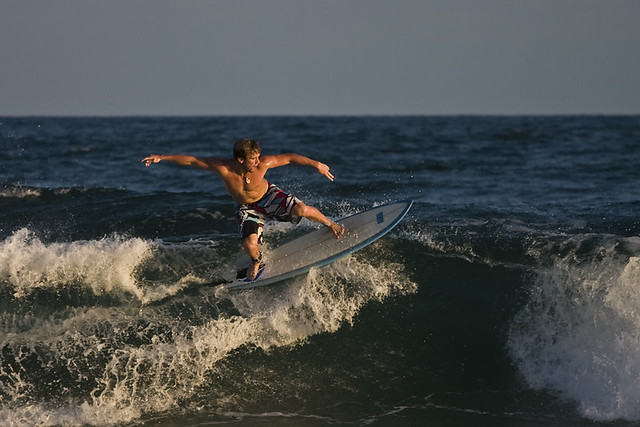In general, action photography is associated with shooting at sports events. It is undeniable that capturing participants in sporting events is challenging, but action photography requires more than that.

“Surfer” captured by The Pug Father
Exposure Time
Action can be immortalized in a photo in two ways: a fast shutter speed to freeze action or a long exposure that creates a blur effect and a feeling of movement.
Moving the camera in the desired direction is relatively easy if you want to “freeze” the moving object, which can be captured even with lower values of exposure time, generally between 1/250 of a second and 1/500 of a second. In the event that the subject is moving at an angle of 45 degrees from the camera, freezing it at the above mentioned values is more difficult.
Choose a shutter speed between 1/500 of a second and 1/1000 of a second for most action. But if you’re shooting subjects moving at high speed, such as cars or running athletes, you’ll need to use a shutter speed of approximately 1/2000 of a second.

“No 141” captured by Derek Bell
Synchronization
One of the most important aspects in action photography is synchronization, which is anticipating the right moment for the photo. If you press the shutter too early, the camera will not capture anything spectacular, and if the shutter is pressed too late, you miss the critical moment.
For these reasons, it’s important to know how to anticipate moments of maximum intensity by practicing. You will often not have to wait for a special event to practice your skills because movement can be found everywhere around us. Try practicing on moving vehicles or your children playing at the park.
Necessary Equipment
Freezing a subject in a photograph can be achieved by using flash.
When it comes to shooting sports activities, telephoto lenses are mandatory. If the action takes place near the camera, lenses with focal lengths between 200mm and 300mm are sufficient. But for the action that takes place on a runway, stage, or stadium, which implies a rather large distance between the camera and the subject, you need lenses with a focal length of 400mm, 500mm, or even 600mm in certain situations.
Positioning
Besides the use of devices that will help capture the subject and setting a proper exposure time, camera positioning is another important factor contributing to the success of action photography.

“Hawks in the Pass” captured by Barry Price (Click Image to See More From Barry Price)
If you manage to transpose the viewer into the atmosphere and set the scene your picture will be even more spectacular.
Further Training on Action Photography
Here is a helpful video from Canon. By combining his passion for photography and sport, Craig Golding has become one of Australia’s best sports photographers. In this sports photography tutorial, Craig highlights the best techniques for high speed sports photography as well as photography tips for how to take action photos.
Best of luck with your action photography efforts, a very fun and challenging type of photography.
Like This Article?
Don't Miss The Next One!
Join over 100,000 photographers of all experience levels who receive our free photography tips and articles to stay current:






Go check out this guy’s sport photos which are all manual focus using Pentax gear.
http://photo.net/photodb/folder?folder_id=707206
http://photo.net/photodb/folder?folder_id=763498